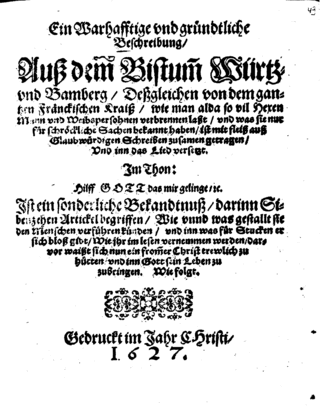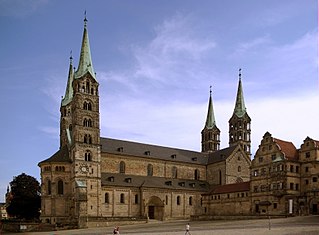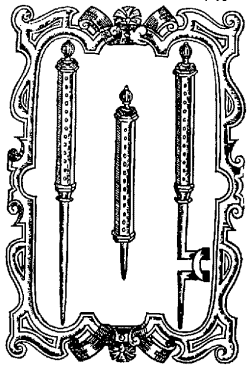Related Research Articles

The North Berwick witch trials were the trials in 1590 of a number of people from East Lothian, Scotland, accused of witchcraft in the St Andrew's Auld Kirk in North Berwick on Halloween night. They ran for two years, and implicated over 70 people. These included Francis Stewart, 5th Earl of Bothwell, on charges of high treason.

Despite its small size, the population of Jersey is made of people with a diverse range of religions and beliefs. Traditionally seen as a Christian island, Jersey's established church is the Church of England, and Anglicanism and Catholicism are practised on the island in roughly equal numbers. Together, these religions account for around half the population of Jersey. Other denominations of Christianity and other religions such as Islam, Judaism, Sikhism, and Buddhism account for handfuls of people on the island. In recent years, irreligion has been an increasing force in Jersey, with two fifths of the population identifying as having no religion. This number rises to 52% for Jersey people under 35.

Agnes Sampson was a Scottish healer and purported witch. Also known as the "Wise Wife of Keith", Sampson was involved in the North Berwick witch trials in the later part of the sixteenth century.

The Würzburg witch trials of 1625–1631, which took place in the self-governing Catholic Prince-Bishopric of Würzburg in the Holy Roman Empire in present-day Germany, formed one of the biggest mass trials and mass executions ever seen in Europe, and one of the largest witch trials in history.

The Basque Witch Trials of the seventeenth century represent the last attempt at rooting out supposed witchcraft from Navarre by the Spanish Inquisition, after a series of episodes erupted during the sixteenth century following the end of military operations in the conquest of Iberian Navarre, until 1524.
The Pappenheimer Case centered around a family who were tried and executed for witchcraft in 1600 in Munich, Bavaria, Germany. The family were executed, along with accomplices they were forced to name under torture, after a show trial as scapegoats for a number of unsolved crimes committed years back in a display of extreme torture intended to deter the public from crime. The witch trial resulted in the death of twelve people: four of the Pappenheimer family and two of their accused accomplices in the first trial, followed by the remaining member of the family and five other accomplices in the second trial. The trial was of one of the most well-publicized witch trials in German history.
Walpurga Hausmännin was a German midwife executed for witchcraft, vampirism, and child murder. The confession she made under torture exemplifies the classical relationship between witch and devil later commonly used in several witch trials.
The Roermond witch trial, which took place in and around the city of Roermond in the Spanish Netherlands in 1613, was the largest witch trial in present-day The Netherlands. It caused the death of sixty four people by burning.

The trials of the Pendle witches in 1612 are among the most famous witch trials in English history, and some of the best recorded of the 17th century. The twelve accused lived in the area surrounding Pendle Hill in Lancashire, and were charged with the murders of ten people by the use of witchcraft. All but two were tried at Lancaster Assizes on 18–19 August 1612, along with the Samlesbury witches and others, in a series of trials that have become known as the Lancashire witch trials. One was tried at York Assizes on 27 July 1612, and another died in prison. Of the eleven who went to trial – nine women and two men – ten were found guilty and executed by hanging; one was found not guilty.

The Bamberg witch trials of 1627–1632, which took place in the self governing Catholic Prince-Bishopric of Bamberg in the Holy Roman Empire in present-day Germany, is one of the biggest mass trials and mass executions ever seen in Europe, and one of the biggest witch trials in history.

John Fian was a Scottish schoolmaster in Prestonpans, East Lothian and purported sorcerer. He confessed to have a compact with the devil while acting as register and scholar to several witches in North Berwick Kirk. He was accused of bewitching townsfolk, preaching witchcraft, and, along with Agnes Sampson and others, raising storms to sink the fleet of King James VI of Scotland and his wife Anne of Denmark as they returned from Copenhagen, having been married in Oslo. He along with several other witches were arrested, examined and put to torture, in what would become known as the North Berwick witch trials.

The Guernsey Martyrs were three women who were burned at the stake for their Protestant beliefs, in Guernsey, Channel Islands, in 1556 during the Marian persecutions.

Witchcraft in Orkney possibly has its roots in the settlement of Norsemen on the archipelago from the eighth century onwards. Until the early modern period magical powers were accepted as part of the general lifestyle, but witch-hunts began on the mainland of Scotland in about 1550, and the Scottish Witchcraft Act of 1563 made witchcraft or consultation with witches a crime punishable by death. One of the first Orcadians tried and executed for witchcraft was Allison Balfour, in 1594. Balfour, her elderly husband and two young children, were subjected to severe torture for two days to elicit a confession from her.

Margaret Aitken, known as the Great Witch of Balwearie, was an important figure in the great Scottish witchcraft panic of 1597 as her actions effectively led to an end of that series of witch trials. After being accused of witchcraft Aitken confessed but then identified hundreds of women as other witches to save her own life. She was exposed as a fraud a few months later and was burnt at the stake.

Christian Caldwell (Caddell) was a cross-dressing witch-hunter active in Morayshire, Scotland during the 1660s.

Sweden was a country with few witch trials compared to other countries in Europe. In Sweden, about four hundred people were executed for witchcraft prior to the last case in 1704. Most of these cases occurred during a short but intense period; the eight years between 1668 and 1676, when the witch hysteria called Det stora oväsendet took place, causing a large number of witch trials in the country. It is this infamous period of intensive witch hunt that is most well known and explored and given attention.
Elspeth McEwen or McKewan or Elizabeth MacEwan of Balmaclellan was the most famous convicted witch in Galloway and the last to be burnt at the stake there.
The Rottenburg witch trials was a series of witch trials taking place in Rottenburg am Neckar in then Further Austria in present day Baden-Württemberg in Germany between 1578 and 1609. It resulted in the death of 150 people. The witch trials were divided in the waves of 1578-1585, 1589-90, 1595-96, 1598-1605 and 1609. The high peak of the trials were the witch trial of 1595-96, when 41 women were burnt alive at the stake between June 1595 and July 1596. Rottenburg were known as a witch trials center and the 1595 trial attracted attention from the University of Tübingen. The Rottenburg witch trials has been characterized as traditional, since the victims were almost exclusively poor old women, and never developed in to the endemic mass trials in which citizens of all sexes and classes could be indiscriminately accused, such as the Würzburg witch trials, and they were conducted under strict control from the authorities.
Margaret Barclay, was an accused witch put on trial in 1618, 'gently' tortured, confessed and was strangled and burned at the stake in Irvine, Scotland. Her case was written about with horror by the romantic novelist Sir Walter Scott, and in the 21st century, a campaign for a memorial in the town and for a pardon for Barclay and other accused witches was raised in the Scottish Parliament.
References
- ↑ Burns, William E. (2003). Witch Hunts in Europe and America: An Encyclopedia. Greenwood Publishing Group. ISBN 9780313321429 . Retrieved 17 December 2012.
- ↑ Ogier, Darryl Mark (1996). Reformation and Society in Guernsey. Boydell & Brewer. ISBN 9780851156033.
- ↑ Parker, T.H.L. (2006). John Calvin: A Biography. Oxford: Lion Hudson plc. ISBN 978-0-7459-5228-4.
- ↑ Tupper, Ferdinand Brock. The Chronicles of Castle Cornet. Stephen Barbet 1851.
- 1 2 3 4 Girard, Peter (1990). More of Peter Girard's Guernsey: A Second Miscellany of Guernsey's History and Its People. Guernsey Press. ISBN 978-0902550421.
- 1 2 3 4 5 6 7 8 9 "Channel Islands Witchcraft: A Critical Survey". Societe Jersiaise.
- 1 2 3 4 5 6 "Witch trials in Jersey - fact, or fiction?". Jersey Evening Post. 23 October 2009.
- 1 2 Strappini, Richard (2004). St Martin, Guernsey, Channel Islands, a parish history from 1204.